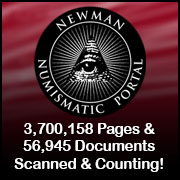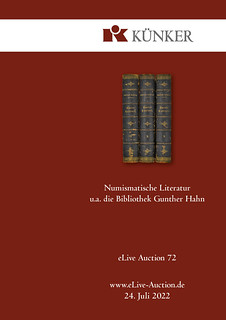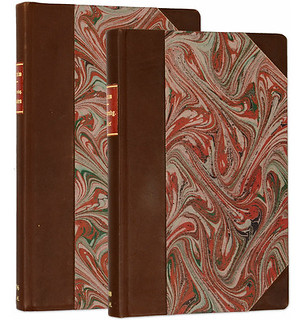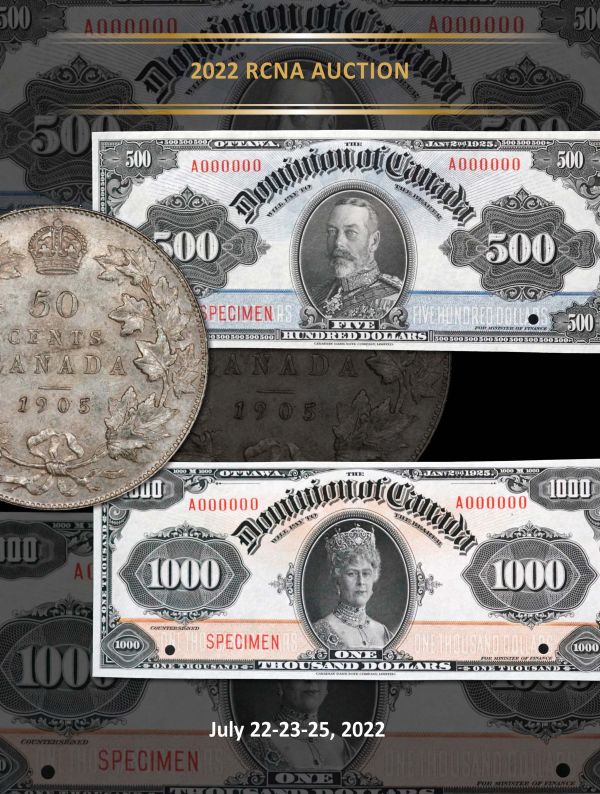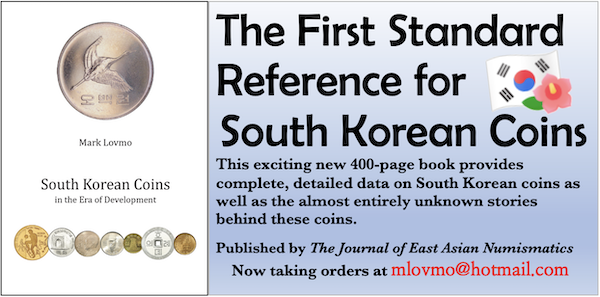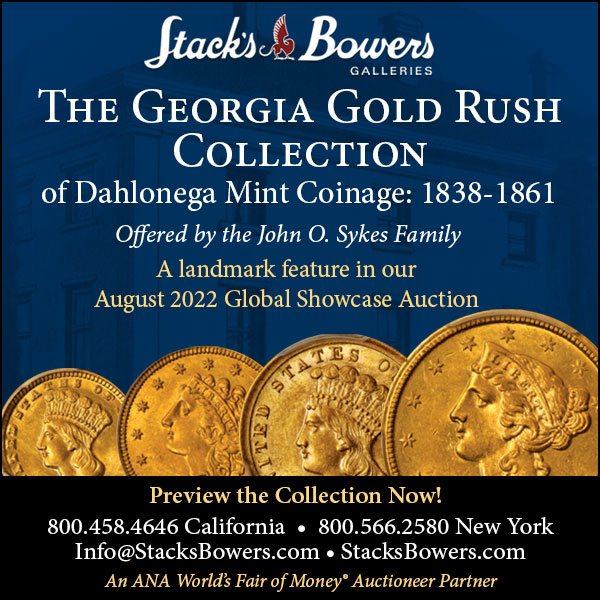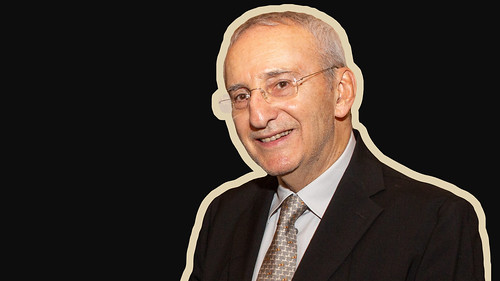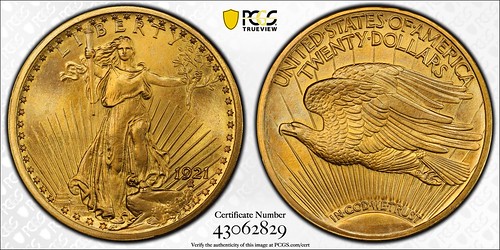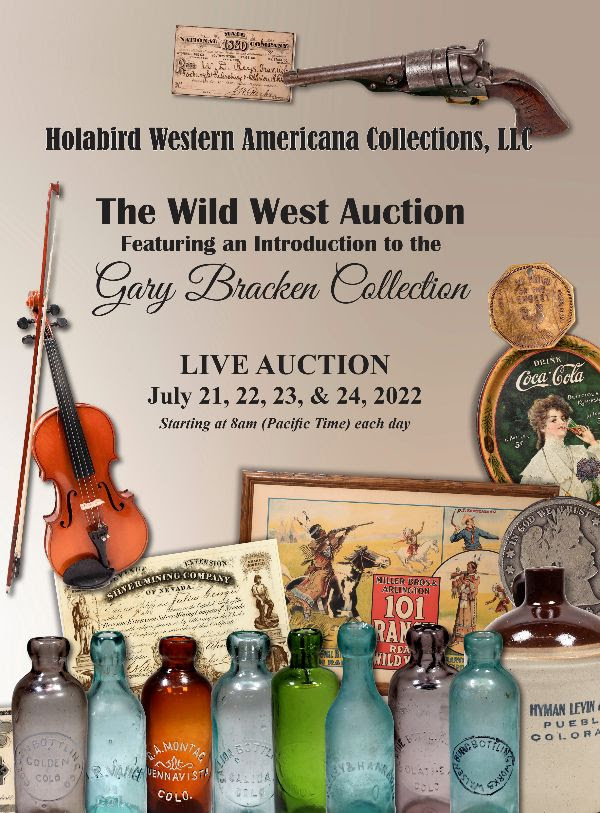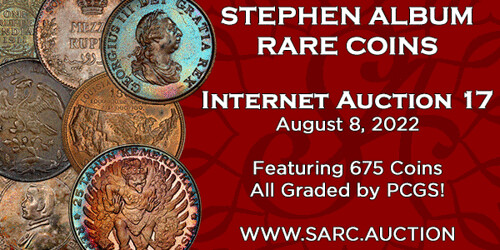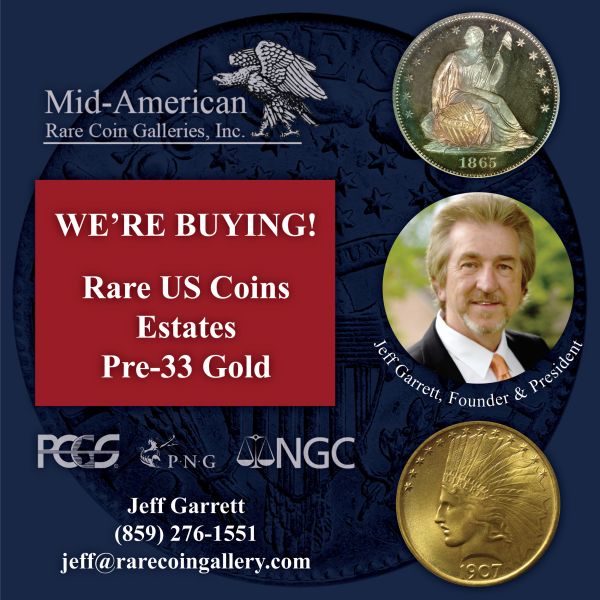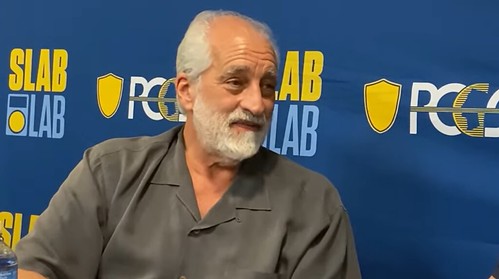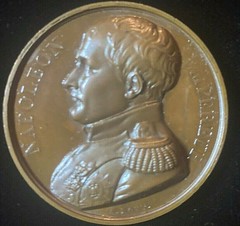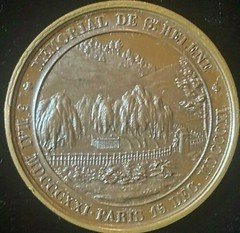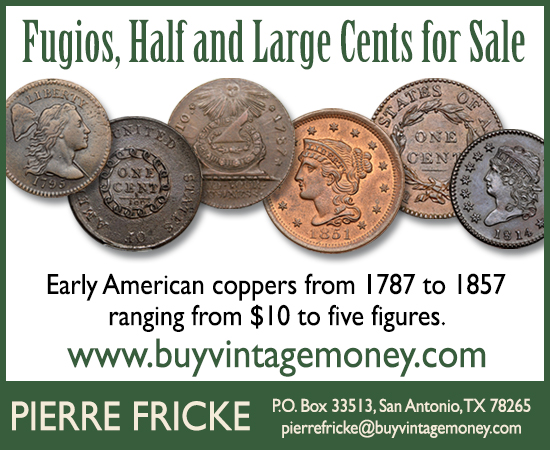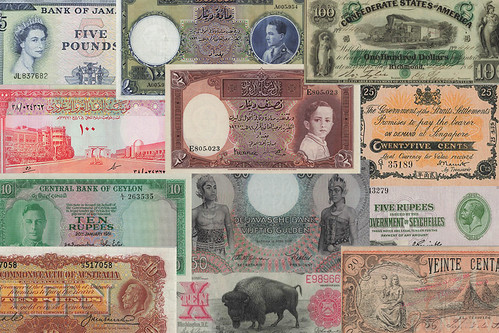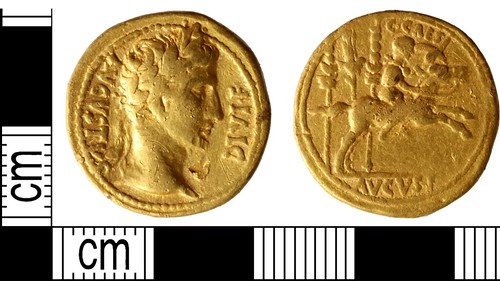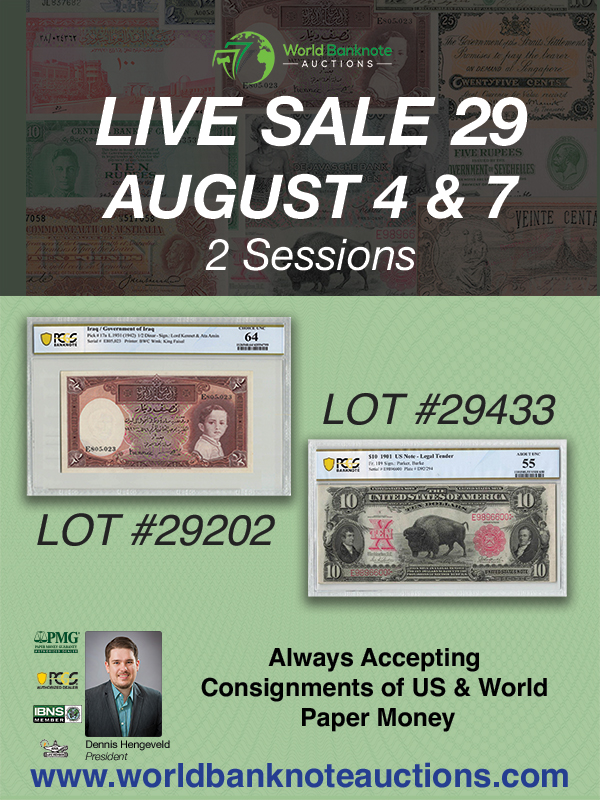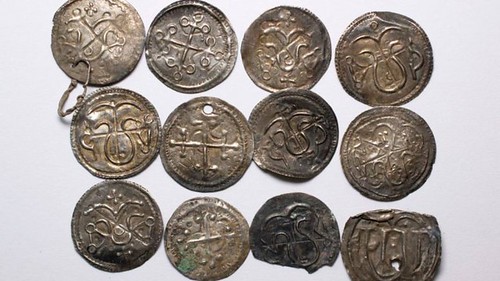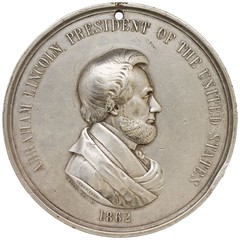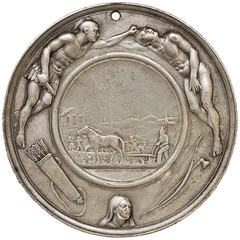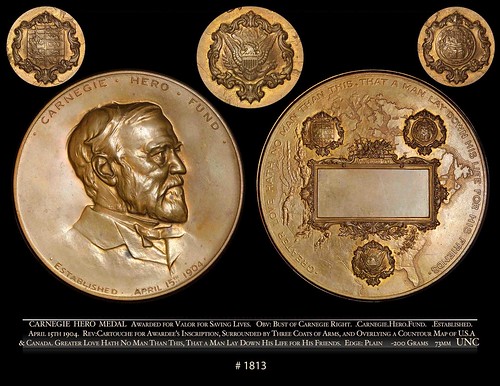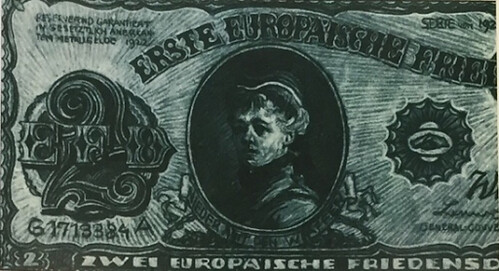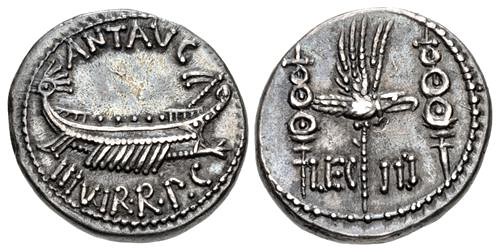
Visit our NBS Sponsors


About UsThe Numismatic Bibliomania Society is a non-profit association devoted to the study and enjoyment of numismatic literature. For more information please see our web site at coinbooks.org SubscriptionsThose wishing to become new E-Sylum subscribers (or wishing to Unsubscribe) can go to the following web page link MembershipThere is a membership application available on the web site Membership Application To join, print the application and return it with your check to the address printed on the application. Print/Digital membership is $40 to addresses in the U.S., and $60 elsewhere. A digital-only membership is available for $25. For those without web access, write to: Charles Heck, Treasurer AsylumFor Asylum mailing address changes and other membership questions, contact Chuck at this email address: treasurer@coinbooks.org SubmissionsTo submit items for publication in The E-Sylum, write to the Editor at this address: whomren@gmail.com BUY THE BOOK BEFORE THE COINSale Calendar |
- WAYNE'S WORDS: THE E-SYLUM JULY 17, 2022
- KÜNKER ELIVE 72 NUMISMATIC LITERATURE
- NEW BOOK: LIBERTY SEATED HALF VARIETIES, VOL. VI
- NEW BOOK: THE CURRENCY OF POLITICS
- KARL MOULTON'S HENRY VOIGT BOOK
- CARNEGIE LIBRARY'S SET OF THE NUMISMATIST
- VIDEO: NEW ORLEANS GOLD COINS 1839-1909
- VIDEO: AN INTERVIEW WITH BASIL DEMETRIADI
- NOTES FROM E-SYLUM READERS: JULY 17, 2022
- OTTAWA RCNA CONVENTION JULY 20-24, 2022
- 2022 ANA HENDELSON COLLECTION EXHIBIT
- 1791 ACT AUTHORIZING THE U.S. MINT
- VOCABULARY TERM: KNUCKLE-JOINT PRESS
- DONALD G. PARTRICK (1926-2020)
- THE ZABRISKIE LEGACY
- REDISCOVERING THE ZABRISKIE COLLECTION
- FRED WEINBERG INTERVIEW, PART TWO
- WEXFORD EBAY MEDAL SELECTIONS JULY 2022
- KÜNKER ELIVE AUCTION 72
- WORLD BANKNOTE AUCTIONS SALE 29
- SYDNEY F. MARTIN COLLECTION PART ONE
- THE HARRY BASS CORE COLLECTION
- GOLD ROMAN COINS FOUND IN NORFOLK
- SILVER COINS OF HARALD BLUETOOTH FOUND
- ANS MAY RETURN PEACE MEDAL TO PAWNEE NATION
- THE CARNEGIE HERO MEDAL
- JOSEF DRACH'S EUROPEAN PEACE DOLLAR
- LOOSE CHANGE: JULY 17, 2022
Click here to read the thin version on the web
Click here to subscribe
Click here to access the complete archive
To comment or submit articles, reply to whomren@gmail.com
Content presented in The E-Sylum is not necessarily researched or independently fact-checked, and views expressed do not necessarily represent those of the Numismatic Bibliomania Society.
WAYNE'S WORDS: THE E-SYLUM JULY 17, 2022
 New subscribers this week include:
Bo Cribbs.
Welcome aboard!
New subscribers this week include:
Bo Cribbs.
Welcome aboard!
Thank you for reading The E-Sylum. If you enjoy it, please send me the email addresses of friends you think may enjoy it as well and I'll send them a subscription. Contact me at whomren@gmail.com anytime regarding your subscription, or questions, comments or suggestions about our content.
This week we open with a numismatic literature sale, two new books and an old one, updates from the Newman Numismatic Portal, notes from E-Sylum readers, convention previews, and more.
Other topics this week include Henry Voigt, Basil Demetriadi, John Pittman, Donald Partrick, Andrew Zabriskie, auction previews, coin finds, the Carnegie Hero Medal and the European Peace Dollar.
To learn more about Liberty Seated Half Dollar die varieties, the first six volumes of The Numismatist, New Orleans gold coins, the Rijksmuseum 1794 dollar, an Act of Congress authorizing the U.S. Mint, the Swedish Games, the Syd Martin and Harry Bass collections, mind-numbingly boring coin shows and the Undead Numismatist, read on. Have a great week, everyone!
Wayne Homren
Editor, The E-Sylum
KÜNKER ELIVE 72 NUMISMATIC LITERATURE
On July 24, 2022, Künker will sell 451 lots of numismatic literature as part of their eLive Auction 72. -Editor
NEW BOOK: LIBERTY SEATED HALF VARIETIES, VOL. VI
Author Bill Bugert forwarded this press release for his latest book, A Register of Liberty Seated Half Dollar Die Varieties, Volume VI. Congratulations! -Editor
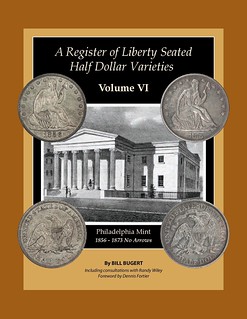 A Register of Liberty Seated Half Dollar Varieties
Volume VI, Philadelphia Mint, 1856-1873 No Arrows
A Register of Liberty Seated Half Dollar Varieties
Volume VI, Philadelphia Mint, 1856-1873 No Arrows
by Bill Bugert
Foreword by Dennis Fortier
With 561 pages and over 1,300 photographs, Volume VI describes all known die marriages (217) for Philadelphia Mint Liberty Seated half dollars from 1856 to 1873 No Arrows inclusive. Included are oversized key diagnostic images, oversized full obverse and reverse images of a late die state example of that die marriage, enhanced die crack diagrams, rarity ratings, important discussion facts, and other related information that will allow you to quickly and easily attribute your half dollars.
NEW BOOK: THE CURRENCY OF POLITICS
This week I came across a review of a new book from Princeton University Press on the broad history and future of money. Also reviewed is one we've mentioned before. -Editor
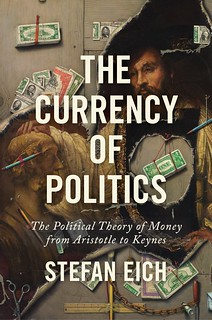 Stefan Eich, The Currency of Politics: The Political Theory of Money from Aristotle to Keynes, Princeton University Press, 2022.
Stefan Eich, The Currency of Politics: The Political Theory of Money from Aristotle to Keynes, Princeton University Press, 2022.
Akinobu Kuroda, A Global History of Money, Routledge, 2020.
We live in a time of unprecedented monetary innovation. Novel private monies like Bitcoin abound, because new technologies have made possible payment systems that bypass traditional banks. With the COVID-19 pandemic having expanded the frontier of unconventional
monetary policies, central banks have been debating whether to create new digital currencies (CBDCs) of their own.
KARL MOULTON'S HENRY VOIGT BOOK
Bryce Brown writes:
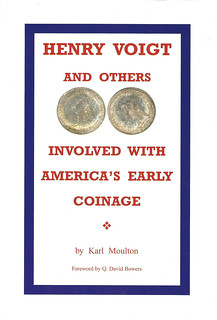 "In the E-Sylum issue Vol 10, No. 29 of July 22, 2007, Karl Moulton discussed his new book "Henry Voigt and Others Involved in America's Early Coinage". After providing a description and details on how to order the book (blue cloth, dust jacket), he finished with "As a treat for the dedicated bibliophile, plans are in the works for a deluxe leatherbound, large paper, and extra illustrated version to be ready later this year. Stay tuned."
"In the E-Sylum issue Vol 10, No. 29 of July 22, 2007, Karl Moulton discussed his new book "Henry Voigt and Others Involved in America's Early Coinage". After providing a description and details on how to order the book (blue cloth, dust jacket), he finished with "As a treat for the dedicated bibliophile, plans are in the works for a deluxe leatherbound, large paper, and extra illustrated version to be ready later this year. Stay tuned."
I cannot find any further mention of this deluxe version, nor any later ads or marketing materials. Nor can I quickly find an appearance of this version in numismatic literature auctions. Is anyone aware of any such marketing materials or ads?"
CARNEGIE LIBRARY'S SET OF THE NUMISMATIST
The latest additions to the Newman Numismatic Portal are photographs of Pittsburgh numismatic events, c. 1989-1990. Project Coordinator Len Augsburger provided the following report. -Editor
The Carnegie Library Copy of the First Six Volumes of The Numismatist
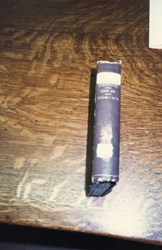 Newman Portal recently processed a group of three photo albums, loaned by Wayne Homren, capturing Pittsburgh numismatic events, c. 1989-1990. Included were the
Newman Portal recently processed a group of three photo albums, loaned by Wayne Homren, capturing Pittsburgh numismatic events, c. 1989-1990. Included were the Invasion of Pittsburgh,
which was a visit to the Carnegie Library during the 1989 Pittsburgh ANA convention. Homren also photo-documented tours of the Frank & Laurese Katen and Dave Hirt libraries, and further captured numerous images related to the 1989 ANA convention. NNP Intern Kellen Hoard compiled metadata for these photo albums, which are now posted.
The highlight of the Carnegie Library tour was the Carnegie copy of the first six volumes of The Numismatist. Ken Lowe mentioned this set in the Money Tree auction sale no. 7 (11/1989), noting In our [March 1989] commentary, we accounted for 13 complete sets of The Numismatist...Another set has since surfaced. This August at the [Pittsburgh] ANA Convention, we were fortunate to be invited to the Carnegie Museum in Pittsburgh to see George Clapp's numismatic library which he bequeathed to them. In the museum holdings was another complete set from 1888 through 1950, which apparently had been forgotten by the collecting fraternity (but not by P. Scott Rubin).
Champa, apparently as a result of this tour, donated rebinding services to the Carnegie, as mentioned by Lowe in the Money Tree sale no. 23 (6/1995, lot 1), …the George Clapp set, one leaf in photocopy, rebound by Alan Grace courtesy of Armand Champa.
VIDEO: NEW ORLEANS GOLD COINS 1839-1909
These are selections from the David Lisot Video Library that feature news and personalities from the world of coin collecting. David has been attending coin conventions since 1972 and began videotaping in 1985. The Newman Numismatic Portal now lists all David's videos on their website at:
https://nnp.wustl.edu/library/multimediadetail/522852
Here's one with legendary collector John Pittman discussing the history and coins of the New Orleans Mint. -Editor
Overview of New Orleans Gold Coins 1839-1909
Baltimore ANA Convention, August 1, 1993.
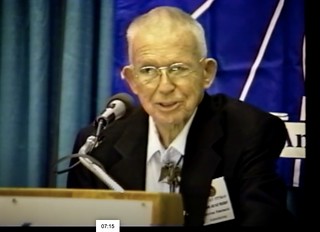 This video covers the history of the New Orleans Mint, with special emphasis on the minting of gold coins. Information is presented as to the probable source of gold bullion used in striking New Orleans coins. The present-day whereabouts of some of these very rare New Orleans gold coins is explored. Special emphasis is given to the double eagles struck at the New Orleans Mint. Speaker: John Jay Pittman.
This video covers the history of the New Orleans Mint, with special emphasis on the minting of gold coins. Information is presented as to the probable source of gold bullion used in striking New Orleans coins. The present-day whereabouts of some of these very rare New Orleans gold coins is explored. Special emphasis is given to the double eagles struck at the New Orleans Mint. Speaker: John Jay Pittman.
David adds:
"John Jay Pittman is a legend in numismatics. He was president of the American Numismatic Association simultaneously while being president of the Canadian Numismatic Association. When his coin collection was sold by David Akers it brought millions of dollars. I had the pleasure of serving with John Jay in 1995 on the ANA Board. He took me under his wing and taught me how to navigate politically in numismatics. He was a friend to me and a serious numismatist. He is one of the great personalities I have had the opportunity to have known in this wonderful hobby."
The video is available for viewing on NNP at:
https://nnp.wustl.edu/library/book/577933
VIDEO: AN INTERVIEW WITH BASIL DEMETRIADI
For years I'd heard from biblio-friends about the legendary Athens library of Basil Demetriadi. Last week's American Numismatic Society Long Table session provided ANS members with a remote tour hosted by ANS President Dr. Ute Wartenberg on location with Demetriadi himself. A video of the session has been made available to the general public on the ANS website - check it out! The library is a mecca for researchers, attempting to house every book, catalog and photograph of ancient Greek coinage. -Editor
NOTES FROM E-SYLUM READERS: JULY 17, 2022
Justice for Zerbe?
Researcher and author
Eric Hodge of the UK writes:
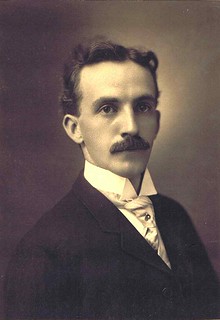 "I am not American. I am not a member of the American Numismatic Association. I am the first to admit that I am not an expert on
American numismatics. I am, however, an interested numismatist. Interested enough to be worried by
the apparent lack of correspondence and concern regarding the recent published information about
Farran Zerbe.
"I am not American. I am not a member of the American Numismatic Association. I am the first to admit that I am not an expert on
American numismatics. I am, however, an interested numismatist. Interested enough to be worried by
the apparent lack of correspondence and concern regarding the recent published information about
Farran Zerbe.
"Under the heading ‘More on Zerbe and the 1909 ANA Election' published in The E-Sylum: Volume 25, Number 26, June 26, 2022, Article 12, Douglas Ward wrote what I considered a rather compelling article rebutting much (if not all) of what David Alexander wrote in a 2016 CoinWeek article.
"It was in a previous issue of The E-Sylum: Volume 24, Number 39, September 26, 2021, Article 17, headed ‘Zerbe Name Removed from ANA Top Award' that I first became aware of the acrimony directed at Farran Zerbe. I was previously aware of Mr. Zerbe from articles and books I had read and was aware of some issues raised, but certainly not to the extent that was now published.
"At the end of this article about the ‘Name Removed' the Editor Wayne Homren wrote; ‘This action seems sudden and arbitrary with no prior discussion of the issues.' He also made other extremely valid points.
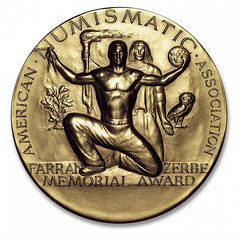 "With the rebuttal article by Douglas Ward I would have expected to read a flurry of opinions, for or against what he wrote. The fact that Mr. Ward finished his comments with ‘One only needed to read the last statements in Mr. Alexander's article to understand his true motivation.' and then went on to mention Chester L. Krause and the proposal to rename the Zerbe award the Krause award makes me wonder if there is some hidden agenda, some conspiracy to alter history, something for us all to worry about. Justice not only needs to be done but it needs to be seen to be done. In this case, in my opinion, it has not been seen to be done."
"With the rebuttal article by Douglas Ward I would have expected to read a flurry of opinions, for or against what he wrote. The fact that Mr. Ward finished his comments with ‘One only needed to read the last statements in Mr. Alexander's article to understand his true motivation.' and then went on to mention Chester L. Krause and the proposal to rename the Zerbe award the Krause award makes me wonder if there is some hidden agenda, some conspiracy to alter history, something for us all to worry about. Justice not only needs to be done but it needs to be seen to be done. In this case, in my opinion, it has not been seen to be done."
Thanks, Eric. I've been surprised myself at the lack of on-the-record commentary on either side of this question, either here or in other publications. -Editor
To read the earlier E-Sylum articles, see:
ZERBE NAME REMOVED FROM ANA TOP AWARD
(https://www.coinbooks.org/v24/esylum_v24n39a17.html)
MORE ON ZERBE AND THE 1909 ANA ELECTION
(https://www.coinbooks.org/v25/esylum_v25n26a12.html)
Other topics this week include "Joe Bickley", M. H. Rubenstein, and he Fantasy Sommer Island Gold "Pound". -Editor
OTTAWA RCNA CONVENTION JULY 20-24, 2022
After a COVID hiatus last year, the RCNA convention returns in-person for 2022. Here's the press release, which includes a number of educational presentations. -Editor
Members of the Royal Canadian Numismatic Association on their way to Ottawa for convention
Historically, members of the Royal Canadian Numismatic Association (RCNA) gathered in various Canadian cities for their annual convention. But COVID changed that. After skipping a year, in 2020, the RCNA held a virtual convention last year. Members will soon be heading to Ottawa, Ontario, the birthplace of the Association, for an in-person convention to be held from the 20 to the 24 July.
2022 ANA HENDELSON COLLECTION EXHIBIT
This press release describes material to be exhibited at the upcoming ANA World's Fair of Money®. -Editor
Described by researchers as one of the most important recent discoveries in
20th century American numismatics,
the unique Experimental Finish 1910 Saint-
Gaudens Double Eagle will be displayed alongside one of the two known Satin Finish
Proof 1921 Saint-Gaudens Double Eagles at the 2022 Chicago World's Fair of Money®.
It is the first time these multi-million-dollar coins will be publicly exhibited together.
1791 ACT AUTHORIZING THE U.S. MINT
Len Augsburger alerted me to another great piece of numismatic ephemera - a 1791 Act of Congress signed by Thomas Jefferson authorizing the creation of the U.S. Mint. It was sold yesterday by Heritage for $137,500.00 (including Buyer's Premium). -Editor
Secretary of State Thomas Jefferson signs Congressional Resolution authorizing the creation of the U.S. Mint
Thomas Jefferson. Act of Congress Signed ("Th: Jefferson") as Secretary of State. [Philadelphia: Printed by Francis Childs and John Swaine, 1791]. One page, printed broadside measuring 9.5 x 15 inches. Uncut folio sheet, creased along old folds, minor foxing, minor paper loss to upper left and lower right corners, not affecting text. Countersigned in type by George Washington (President of the United States), John Adams (Vice President, President of the Senate), and Frederick Augustus Muhlenberg (Speaker of the House).
"Resolved by the Senate and House of Representatives of the United States of America in Congress assembled, That a Mint shall be established under such regulations as shall be directed by law..."
VOCABULARY TERM: KNUCKLE-JOINT PRESS
Here's another entry from Dick Johnson's Encyclopedia of Coin and Medal Terminology. -Editor
Knuckle-joint Press. A press whose action is based on a hinged joint and flywheel. This type of press has a relatively long extrusion dwell, particularly useful for preventing the springing back of the surface metal. This type of striking is ideal for both numismatic and medallic items, in fact more of the world's coins and medals have been struck on knuckle- joint presses than any other.
DONALD G. PARTRICK (1926-2020)
American Numismatic Biographies author Pete Smith submitted this article on colonial coin collector Donald G. Partrick. Thanks! -Editor
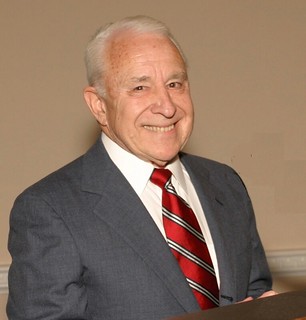 Readers of The E-Sylum may recall the mystery surrounding the death of Donald Partrick. No
obituary or death notice was published and there has been little biographical information
published about him. This is an attempt to correct that.
Readers of The E-Sylum may recall the mystery surrounding the death of Donald Partrick. No
obituary or death notice was published and there has been little biographical information
published about him. This is an attempt to correct that.
Donald Groves Partrick was born on January 6, 1926, the son of George F. (9/7/1889-7/1979) and Violet W. Partrick (1896-10/20/1952). His father was listed as an insurance broker or mortgage broker.
THE ZABRISKIE LEGACY
Although the primary coin collection of Capt. Andrew Zabriskie was sold by Henry Chapman, another sale took place at a much later date as discussed in The E-Sylum last year. The July 1999 issue of The Rail Splitter has a cover article by Donald Ackerman titled "The Zabriskie Legacy" with a sidebar article by David E. Tripp. With permission, we're republishing these here. -Editor
THE ZABRISKIE LEGACY
Donald L. Ackerman
Few collectors of political Americana know the name Andrew C. Zabriskie. But numismatists (coin collectors) are more than familiar with that moniker —- and, more importantly, what it represents in the way of provenance. Zabriskie was one of the most prominent collectors of American coinage in the late-nineteenth and early twentieth centuries. In fact, Zabriskie served as President of the American Numismatic Society at the turn-of-the-century. The sale of his collection by Henry Chapman in 1909 is considered, even today, a seminal event.
Ancient history... why then, should today's Lincoln collector be concerned with him? For one thing, he amassed what will always be considered the single finest assemblage of Lincoln tokens, medals, and political badges. Second, in 1873, at the age of nineteen, he published — at his own expense — the very first catalog devoted
exclusively to Lincoln medals: A Descriptive Catalogue of the
Political and Memorial Medals Struck in Honor of Abraham
Lincoln, Sixteenth President of the United States. A total of 187
medals (including metal varieties) were each assigned a number
(a Zabriskie
number). The sequence was based on descending
order of size, with measurements in the American scale
prevalent at the time. Only seventy-five copies were printed, each selling for $1.50. (A flawed copy of this scarce work recently sold in
the Harry Bass sale for $300).
REDISCOVERING THE ZABRISKIE COLLECTION
The July 1999 issue of The Rail Splitter has a sidebar article by David E. Tripp about the 1999 discovery and sale of important remnants of the Andrew Zabriskie collection. With permission, we're republishing these here. -Editor
David E. Tripp, Special Consultant and former Director of Sotheby's Coin Department, cataloged the Zabriskie holdings. We asked him to recount how he personally "rediscovered" the whereabouts of that collection.
In early January of this year, I received a call from an old acquaintance with whom I had worked years ago, and for whom I had recently given some informal advice on a completely unconnected issue. She informed me that her father had recently died, and that her mother had inherited a collection of medals relating to Abraham Lincoln. Would I be able to go and have a look and give her mother some idea of what the materials might be worth. Needless to say, I was more than happy to do what I could.
"Oh, by the way," she asked, "have you ever heard of Andrew Zabriskie?" That stopped me. Of course, to a numismatist Captain Andrew C. Zabriskie's collections of coins, sold by Henry Chapman in 1909, was one of the greatest cabinets of American coins to ever come to auction. It included an example of America's most famous coin, the Brasher Doubloon. (Ironically that piece recently changed hands for nearly $1,000,000, and at Sotheby's a few years earlier, as part of the Bloomfield Foundation Collection, we had sold another coin from Zabriskie/Chapman for $165,000). Chapman was a landmark sale.
Over the weekend I looked at a tattered old copy of the Chapman sale catalog which I own, and noticed that while there was a great deal of political material, there was little if any material related to Lincoln. His Indian Peace Medals were virtually complete...less Lincoln. In checking the Lincoln Bibliography, I notice that he had published on the subject in 1873, and so was intrigued. I confess I had no idea that Captain Zabriskie was one of the early titans of collecting politicals, as well as coins.
The collection was laid out in a few shoe-boxes. Many pieces were simply wrapped in tissue paper. Some had at some point been slipped into old plastic sleeves. As each piece emerged from its cocoon, the importance of the holding began to reveal itself. Certainly when the Lincoln Peace Medal was unwrapped, I was astounded. It was the most perfectly preserved Lincoln I had ever seen (and I have been reliably informed that it may well be the single most perfectly preserved Indian Peace Medal of any president). Even uneducated in the secrets of the politicals market, the array of 35 ferrotypes was memorable.
As the extent of the collection became apparent, I idly asked if there was any more. Indeed there was, in the upstairs closet, in a suitcase. This, upon retrieval, contained many of the storecards from New York was well as the extraordinary run of Civil War tokens. In the end, the owner, a delightful lady, simply instructed us to take it away. As it was being receipted, I asked about how it had been retained intact for all these years.
It transpired, that in 1951, the family gave Captain Zabriskie's home, Blithewood, together with 1,000 acres to Bard College, up the Hudson River. The weekend before the closing, the husband of our consignor (Zabriskie's grandson) received a call from his brother, and was told that the closing was to be the following Monday, and that if there was anything in the house he wanted, to come up on Saturday and take it away. They went up to Blithewood and discovered the long-forgotten family safe, door sealed, combination unknown. They were confident that nothing of value remained in their grandfather's old safe, but decided at the last minute to have it drilled to make certain that personal, family papers were not left behind. To everyone's amazement, within was the collection, not only of Lincoln medals and storecards, but also the Captain's collection of Polish coins, which the family later donated to the Smithsonian Institution.
While I had some idea of what we were into, the size and importance of the collection was a most pleasant surprise. When we had got it all into some order, several specialists came to have a look. I was delighted that their reaction was similar to mine. As some of the great rarities came to light it was as if they were gazing on the Grail. A delightful experience indeed.
The Zabriskie holding is the rare survival of a wonderful "first generation" collection, and one can rest assured that the new owners will derive as much pleasure from their new purchases as did the Captain more than a century ago.
FRED WEINBERG INTERVIEW, PART TWO
Published in Errorscope earlier this year, Greg Bennick's interview with dealer and longtime E-Sylum supporter Fred Weinberg is a wonderful look at the hobby and business of error coin collecting over the last half century. With permission from the Combined Organization of Numismatic Error Collectors of America (CONECA), we're republishing it here. Here's part two of four, where Fred discusses some of the famous error collectors and dealers he's known. -Editor
Greg Bennick: Wow, what do you remember about him? I think most people only know his name...and his effect.
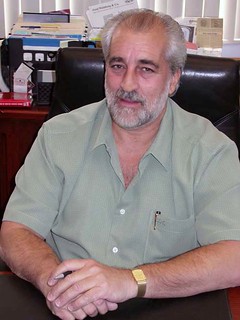 Fred Weinberg: You know what, Mort Goodman once told me his first name and I forgot it. I believe he only
went by Blakesley, because he didn't like his first name. Whether it was Reginald or something corny-sounding, I'm not sure, but he was known as Blakesley. He was very tall and lanky, balding. I can picture him
like I saw him yesterday. He was very soft spoken, very analytical and he's the one that noticed the weakness
of the rim on most clips opposite the clip that's become known as The Blakesley Effect. But he also diagnosed
and wrote about in great detail the other two methods of authenticating clipped planchets, which is number
one, the metal flow towards the clip, and number two, what we call the cut and tear marks, which you can see
on a curved clip and a straight end clip. You won't see these on a ragged or end of sheet clip.
Fred Weinberg: You know what, Mort Goodman once told me his first name and I forgot it. I believe he only
went by Blakesley, because he didn't like his first name. Whether it was Reginald or something corny-sounding, I'm not sure, but he was known as Blakesley. He was very tall and lanky, balding. I can picture him
like I saw him yesterday. He was very soft spoken, very analytical and he's the one that noticed the weakness
of the rim on most clips opposite the clip that's become known as The Blakesley Effect. But he also diagnosed
and wrote about in great detail the other two methods of authenticating clipped planchets, which is number
one, the metal flow towards the clip, and number two, what we call the cut and tear marks, which you can see
on a curved clip and a straight end clip. You won't see these on a ragged or end of sheet clip.
I can remember the diagrams he drew of the planchet going through the upsetting mill and why with the lack of metal at this point it would cause a weakness in the rim opposite to that, because there wasn't enough corresponding pressure. So it was fascinating because people had noticed this effect, but nobody had put two and two together until Blakesley had written his papers. It opened up methods of authentication for the common coin collector to be able to authenticate their own coins anywhere in the country which they'd found without having to send those pieces into Collector's Clearinghouse.
Greg Bennick: So fascinating! My dad tells stories of finding errors in change in the 1950's. And that when he was finding clipped planchets and also laminations, that he didn't know what to do with him. He said he had bags of them and eventually just spent them because they weren't worth anything. At the time, is that where most people were finding their errors, their double strikes, and slightly more even major errors at the time? Were people pulling them out of change?
Fred Weinberg: I can tell you, believe it or not, that in 1967, ‘68, ‘69, there were not a lot of major off center or even double struck Lincoln pennies around. And if you look today at dates in the 1950s and ‘60s, you'll see that they're kind of scarce. Yeah, there might have been more after 1965 when they took out silver from our coins and started ramping up production in higher mintage figures. This produced a few more errors, but we rarely saw very expensive or rare error coins at all at the club meetings. At the Error-A-Ramas people would exhibit, so you'd see some great examples like a clock of off-center buffalo nickels, or a clock of double struck pennies. But at the regular monthly meetings it was things that most people found, which would have been - like you said - clips, laminations, die cracks and those sorts of things. I had a little mail order business when I was probably 15, 16 selling BIE's and die cracks for 15, 20, and 30 cents apiece plus a few postage stamps.
That was my first actual dealing in coins as a business, and it was fairly successful. You can't get rich selling coins for 25 cents apiece, but you meet a lot of friends and learn a lot that way.
Greg Bennick: So, you've mentioned that first Error-A-Rama, June 1967. What do you remember about that first error convention? That must have been really exciting!
Fred Weinberg: Well to be honest, it was actually the weekend before my high school graduation and prom night, and I made sure I had enough money for a corsage for my date and that was it! I saved the rest of my money to spend the following week at the Error-A-Rama in Hollywood. The show was put on by Mort Goodman, who I consider one of the grandfathers of the error hobby. Mort and other people were starting to get a club together in Hollywood. Error-A-Rama was at this beautiful hotel, and they had a room with bourse tables, and showcases and everything. There were dealers that I had just read about or seen their ads in the NECA - it was NECA at the time, not CONECA - the NECA Errorscope. I would see names of people I recognized and got to meet them in person. A lot of them became members of the Error Club of Hollywood, but some people had flown from back east. It was the first time I ever met Arnie Margolis who came in from New York. There was also a gentleman there named Philip Spier from the south who had an incredible collection of coins.
You know, it really wasn't until I bought in 1974, the Bolt collection, the Dr. Conway Bolt collection of errors, that I realized that there were very few collectors that understood or had any interest in error coins in the 1930s, ‘40s and ‘50s. It picked up a little bit probably in the mid to late ‘50s to some degree. But Mort and Arnie really got it going in the mid 1960s. That was what I would call, the first new wave of error collecting. It was because of Mort and Arnie and the club and NECA in the mid 1960s.
Greg Bennick: And do you think that upswing was caused by them spreading education about the minting process, or was it info about particularly interesting error types?
Fred Weinberg: It was both of those things. Mort, just before I met him at the Error Club of Hollywood, literally drove around the United States during 1965 and 1966 giving coin club talks about the minting process and about error coins to any club in the country that would listen to him. He had this old two door car and drove it all over the country with his wife Jane, and they gave talks on the minting process. That motivated a lot of people. I think when Mort saw how interested people were to come to these meetings, that's when he started thinking about maybe an Error Club up in Hollywood, and the Error-A-Rama. They got going around the same time.
Greg Bennick: I remember hearing about Mort Goodman driving around the country. I think it was something you mentioned to me at a coin show. But hearing you describe it in that way is so astounding, because that truly is groundbreaking, especially at that time. It's sort of like The Red Book and Jack Kerouac all in one.
Fred Weinberg: That's very good! You're right. And Arnie was the one who came up with the graphics. If you look around in older issues of error magazines, there was something called Margood, which was Margolis and Goodman. They came up with a little company where you could get a picture of a Lincoln penny on a two-by- two piece of cardboard. Arnie did most of the printing, And the hole, instead of being in the center was off to the left, or to the right, and there was a diagram of a penny. You could staple the coin into that two-by-two holder and then draw on the diagram of Lincoln where the BIE was, where the die crack was, where the lamination was, and so on. That was ground breaking. It was pretty popular for a couple of years, though it lost interest over time.
But Arnie and Mort, were from both extremes across the country and they were good friends. You had Arnie in New York and Mort here in California. They were without a doubt the two people who most motivated me. Probably 80%, if not 90% of the coin collectors back in the 1960s who ended up collecting errors, were motivated and inspired by them as well.
Greg Bennick: That's fascinating. I'm actually curious about some of those names from back in the day because there's so many iconic, not just publications, but books such as The Design Cud or even Error Trends Coin Magazine and these helped form the foundation of the hobby. I was really fortunate to have met Arnie when I was a teenager. My dad took me to a coin club meeting on Long Island when I was 14 or 15 years old. And I met Arnie and Rich Schemmer and their friends. Arnie was certainly a character.
Fred Weinberg: Yes, he certainly was.
Greg Bennick: What do you remember about Arnie specifically? Because of course since his passing, he isn't here to speak for himself, but certainly Error Trends Coin Magazine as far back into its origins the 1960's, seemed to be hugely instrumental in bringing information and education to the hobby.
Fred Weinberg: Arnie started his first issue of Error Trends in early 1968. He had done a sample copy after the
Error-A-Rama, and the Error Club of Hollywood started. There's a sample copy which says sample copy
on it
that I think is from the fall or winter of 1967. But I believe the first official issue was 1968. When I met Arnie in
1967 at the Error-A-Rama here in Hollywood, we for some reason just hit it off and became very good friends.
Up until the end I would visit him at his house. He invited me to West Point, and I took my very first tour of the West Point Mint with him. He was definitely a character. I was born and raised in Los Angeles and I'm more of a laid-back California-type person. Arnie was very, very New York-ish type person. Normally one would expect that we would have been like oil and water, but for some reason we always hit it off. It was like a son / father relationship. It always fascinated people to see how well he and I got along when it was hard sometimes for Arnie to get along with other people. Arnie was opinionated.
Greg Bennick: He certainly was! Those opinions were the basis of so many articles throughout the ETCM years. Why don't we talk about a couple of other iconic names, and people most of us never got a chance to meet. What could you tell us about Natalie Halpern? The hobby seemed male dominated, and as a woman so highly involved, she seemed rare.
Fred Weinberg: Natalie was not only unusual for being a female coin dealer, much less an error dealer, but also just as a woman collecting coins. Even this was very unusual back even in the 1960's. I would see Natalie every time I went to a New Jersey or New York coin show. She was always very friendly, always gregarious, smart, sharp. Everybody loved dealing with her. Back in those days back east, you'd deal with Natalie Halpern, or you'd deal with Pete Bishal. There was a crew of people on each coast. People didn't travel as much to shows. Because of my job at a company called Numismatics Limited at which I worked, I would fly to the bigger shows around the country. So I'd always go to shows in New York, New Jersey, or sometimes even Connecticut. Natalie didn't go to Chicago or to the south or out west, but I would always see her in New York.
She was always great to deal with. She had a great sense of humor was a sharp dealer.
Greg Bennick: While we're on the subject, you mentioned Pete Bishal. The error hobby - because it deals with unusual and strange coins - attracts some unusual and strange people. Pete Bishal was certainly another one of those. I know that I bought coins on a number of occasions from Pete. I had came up as a punk rock kid and was singing in punk rock bands and when I first met Pete Bishal, I thought, wow, here's a guy who seems as bizarre as I feel! I always enjoyed seeing him at coin shows. What do you recall about him?
Fred Weinberg: Well, Pete was an absolute trip. He was gregarious and very energetic and outgoing. He was also very knowledgeable. His main area of study and claim to fame was that he studied all the different die varieties of the 1878 dollar and using the Van Allen book - the VAM book - Pete was the first person who made the argument that one of these VAMs, and I cannot remember it was VAM 18 or VAM 27, was actually one of the first coins struck at the mint when they first struck 1878 silver dollars. He did that for both the Philadelphia and San Francisco issues. So he was a true student or errors and of coins and he really studied this stuff. At shows he was always entertaining. He had a crazy personality, and everyone liked him. But like you said the error hobby attracted people who were attracted to strange coins and everybody involved had a quirk or two.
Greg Bennick: One more classic name. I want to ask about Lonesome John Devine. He was another character we haven't discussed. Can you tell us a bit about him and the role he played in the hobby?
Fred Weinberg: I would say after people like Mort Goodman and Arnie Margolis, John was probably the third or fourth most influential person in the error hobby, because he was a big promoter as well as a dealer. He had his publications, he had a publishing company called HiHo Printing where he would publish his own little price list. And for a while I think he printed the Errorscope too. John was a great guy, very knowledgeable, very smart, very friendly. And I used to go out and visit him in Newbury Park, which is coincidentally, maybe 20 minutes at the most, from where I am right now here in the Valley. John was great, and had a very, very positive effect on the error hobby. He didn't travel to coin shows. I don't even think he went to the Long Beach shows. But his promotion of coins and errors and his price lists were very, very instrumental in making errors more popular.
Greg Bennick: I love it. So how did you move from being a collector to becoming a dealer? You mentioned selling BIE pennies and things like that, and later Numismatics Limited. Was Numismatics Limited your company?
Fred Weinberg: No, and actually what I probably should tell you, and I've told this story before but it's important to me is that I had the paper route, and I had that little mail order business selling 25 cent, 30 cent error coins. But there was also a coin shop in Los Angeles called Jonathan's Coins on Manchester in Inglewood, close to Randy's Donuts. I would go in there, especially on Tuesday nights, but also on Saturdays in about 1967, ‘68, ‘69 when I could drive. It was maybe 20 minutes away from where I lived. Jonathan's Coins in Inglewood had probably the largest if not the second largest bid board in the country. There would be hundreds of people every Tuesday night fighting each other to put that last bid on the little card on the bid board and I would go there and get worked up if there was an error coin I wanted to buy. Then you'd hang around and make friends. I kind of got to be known as an error guy at Jonathan's.
Well, fast forward a couple of years later. This is now 1971. I'm now 21 years old and at my parents
house in Cheviot Hills. I'm with my girlfriend at the time and she was baking chocolate chip cookies during
Christmas break. I got a call from Jonathan's, and they said, Fred, there's a guy here with a bunch of error
coins. He wants to sell them. I don't know anything about them. I want you to come out here and buy this deal
for me.
So I said, Okay!
And I left the chocolate chip cookies, which is probably the only time in my life I have
and ever will leave freshly baked chocolate chip cookies. I ran over to Inglewood to the coin shop, walked in
and Jonathan told me that guy was in the conference room. I said, Jonathan, I don't know how to do any of
this…what do I do?
He said, It's real simple. Buy them so that I can put them in the showcase and sell them
and make a profit. It's that easy.
I went into the room and it turns out that the person who was selling these coins was another error
dealer named Jim Layman. He was from Parma, Ohio and he was driving out to Northern California to relocate
and knew Jonathan's had a bid board and a coin shop and he thought, Well, I'll sell my error inventory there.
I
had heard of him. He was intimidating only in the sense that he was older than me, probably in his 30's I'm
guessing at the time, maybe a touch older than that, and I'd seen his name. I thought, He's a dealer. Well,
what the hell am I doing?
Well, the short version of the story is, I ended up buying the deal from him. Jim Layman is still, to this day, my life insurance agent, because that's what his main job was in Parma Ohio. He's still a life insurance agent in Modesto, California. I ended up buying the deal from him. He left and I recall it was about $2,200, which was a lot of money for error coins for a collection at the time. I can't remember any of the coins in the deal, but I remember the rough total amount. We gave him a check, and he left.
Jonathan came up to me and said, I like the way you handled yourself, do you want a job here?
Until
that second I had never ever considered being a coin dealer. I was happy to just be a collector. But the second
he asked me that question, I knew that's what I wanted to do. I told him, Yes I do!
I said that I'd start in a
couple of weeks at the beginning of the year. We agreed that I would start at the beginning of February which is exactly 50 years ago. And I then went home and told my girlfriend, but it took me about four days to come up
with the nerve to tell my middle class Jewish parents that I was dropping out of college to become a coin
dealer!
Greg Bennick: That's amazing.
Fred Weinberg: It was terrifying! And surprisingly, they were pretty, pretty supportive as I recall. I finished my college tests and started the beginning of February, and worked there for a little over a year and that was my job until I got hired at Numismatics Limited, which is another story.
Greg Bennick: Well, let's jump into that. But just as a quick aside, you know I've made my living as a speaker
and performer for my entire life and I've mentioned to you that I started out as a juggler when I was a kid and
still use juggling and various comedic tricks in my shows. But I had the moment too, where I had to tell my
parents, Guess what? I know you went to an Ivy League school, but I'm going to be a professional juggler for
the rest of my life!
So I know that feeling of dread and wonder and awe and hope!
Fred Weinberg: Exactly, the dread! And you know what looking back, I probably would have done better with my parents if I told them I wanted to be a juggler than a coin dealer. [laughter] But actually, they were fine with it. So what ended up happening was that Jonathan, though he had a big coin shop and was successful, was taking too much money out of the business himself. He never had enough cash flow. So every time somebody would come in and he would buy a coin, he had to cover the checks. So, two or three times a week I would have to drive up to Beverly Hills from Inglewood with whatever gold or rare coins we had bought in the shop that week to sell to this company called Numismatics Limited to get enough to cover the checks for everything else that he had written checks for in the prior few days.
After doing this for about a year and meeting the three owners of Numismatics Limited, I was in there
one day and the two owners started asking me questions. We were in their office and they asked me, So, how
do you like working at Jonathan's?
I replied, Oh it's great. I love it. It's exciting.
They asked, Really…you
really, really enjoy it? Are you happy there? Are you learning?
And I said, Oh yeah, I'm learning a lot! It's
great. I'm buying and selling. It's wonderful!
They went on and on for at least twenty minutes asking me if I was happy there. I must have been
naïve and not realized what was happening. But finally, out of exasperation, one of them said to me, Hey idiot
we're trying to offer you a job!
Greg Bennick: Laughs] And how many years were you with Numismatics Limited?
Fred Weinberg: I was at Numismatics Limited for thirteen and a half, maybe fourteen years.
Greg Bennick: And I'm assuming you did a lot of traveling for them?
Fred Weinberg: Oh, I traveled. While I was at Numismatics Limited, I went to coin shows probably an average of three times a month for 10 months. No traveling in December, maybe one coin show in November but the rest of the year it probably averaged two and half times a month for at least 10 months. I went to a couple of dozen shows a year. Central States, FUN, all sorts of different shows across the country. I've been to a lot of different cities, everywhere. It was fun.
Greg Bennick: That's really cool. Well let's do this. Let's dive into some questions about actual coins themselves because, well, you've seen everything! You mentioned earlier buying the Bolt Collection. Can you tell me about that?
Fred Weinberg: Sure, and that's kind of a unique story too. I was at Numismatics Limited for about two years,
and one day a gentleman named John Hammrick who owned a big company called Worldwide Coins in Atlanta Georgia came out for the Long Beach Coin Show. He called me up and said, I've got this collection of errors.
Do you want to buy it?
And I said, Certainly.
He replied that he'd come by the office in a couple of hours.
I talked to Harry Gordon, the owner of the company, and I told him that there was this is a big deal
coming in and I said that I thought I could make good money on it. He was so cool, and said, That's fine, no
problem whatsoever.
So John Hammrick came into the office, and the collection he brought had a little over
2000 major dramatic rare US coins, mostly type coins from 1795 to about 1955. There was nothing after ‘55,
maybe 1956. And the man who put together this collection, Dr Conway Bolt, was a famous collector known for
his errors. I've found references to his name in some of the early Penny publications and you might see his
name too in some of the publications that you have. He had this incredible collection. The family took it in after
he died - I'm assuming around 1973 - to Stacks, and Stacks offered them $10,000 for the whole deal.
They didn't sell it and instead because Conway Bolt's family was in the south, and Worldwide was in
the south, they sold it to Worldwide. I have no idea what Worldwide paid for it. But he came into my office with
eight or ten double row stock boxes of two by two coins. Again, remember that it was over 2,000 coins, and
there was no way for me to figure out a cost on every single one of these coins.
So what I ended up doing was that I made a decision to start with the first boxes. They were numbered
and I just ran a tape of what I would pay for the coins. Worldwide wanted $50,000 for the collection, so to figure
out if it would work – without pricing every single coin individually - I started going through the boxes of coins
with a calculator typing in their retail value, and when I got to the $50,000 and there was still like a box and a
half left, I thought, I own the deal.
So we bought the deal for $50,000.
To sell it, I told the boss, Look, I don't want to cost 2000 coins. The easiest thing for me to do, with
your permission Harry, is to let me sell these coins. The first $50,000 will all be cost and then everything over
that will be pure profit and that's just a lot easier to figure.
And he said that's fine. Well, to promote the Bolt
Collection, I took out ads in Coin World, Arnie
Margolis wrote a couple of articles in Error Trends, and between customers I had and flying around to a
couple of places in the south with coins to sell at coin shows, I had sold $150,000 worth of error coins in one
year and I still had two or three good pieces. I ended up getting, I'm guessing if I can remember correctly,
around $165,000 for the collection a year later, selling it one coin at a time. That was a lot of money back in
1974 to make on a coin deal.
Greg Bennick: Do you know if that collection is documented anywhere? Mike Byers seemed to think that he had a copy somewhere of what was in the collection but wasn't sure where his copy of the listings were.
Fred Weinberg: Yes, it's documented in a couple of different areas but unfortunately because I'm retiring I've packed everything away so I don't even have access to it right now. There was an inventory list that somebody typed up from Numismatics Limited of all the coins that I had shipped to Arnie for photographs in Error Trends. And that probably was 40 or 50 coins. Then I came out with a little booklet that was the same size as Error Trends, and it said the Dr Conway Bolt Collection on it. And it didn't list all 2,000 coins because I was busy selling them but it listed a few. It was such an incredible collection that I all I had to do was just take them to any local coin show, or any coin show around the country for that matter and I would easily sell them. Most people had not seen so many type coin errors. I mean there was some spectacular error coins from half cents to US gold coins. It was truly spectacular material.
For more information about CONECA, see:
https://conecaonline.org/
The PCGS Slab Lab series has some video interviews with Fred. Here's the latest. -Editor
To watch the video, see:
Slab Lab Episode 11 | Fred Weinberg Part 2
(https://www.youtube.com/watch?v=YRyUz3Tt7eU)
To read the earlier articles in this series, see:
Fred Weinberg Interview, Part One
(https://www.coinbooks.org/v25/esylum_v25n28a15.html)
WEXFORD EBAY MEDAL SELECTIONS JULY 2022
Rich Jewell's Wexford Rare Coins and Medals eBay store features a number of great medals along with other numismatic items. Here are some that caught my eye this week. -Editor
1841-1842, Antoine Bovy,sc., Sainte Helene memorial medal, copper 1-3/5", "anchor & copper"
Obverse- Napoleon Empereur, his bust facing left. Signed under bust a. Bovy
Reverse- "Memorial de Ste.Helene 5 MAI MDCCCXXI Paris 16 DEC MDCCCXL. A view of Napoleon's memorial in Saint Helene.
This original copper medal was struck under Louis Philippe to commemorate the return of Napoleon to his motherland in 1840.
A decent Napoleonic medal. -Editor
To read the complete lot description, see:
1841-1842- Antoine Bovy, Sc., Sainte Helene Memorial Medal, copper, 1-3/5
(https://www.ebay.com/itm/194420177293)
KÜNKER ELIVE AUCTION 72
Here's the press release for the Künker eLive Auction 72. -Editor
Künker eLive Auction 72 – Something for Everyone
The summer auctions are only just over and the next Künker auction is already about to start. On 6 auction days, over 3,400 lots with coins and medals from the ancient world to modern times, orders and decorations from all over the world as well as numismatic literature await you in eLive Auction 72.
THE BOOK BAZARRE
WORLD BANKNOTE AUCTIONS SALE 29
Here's the press release for World Banknote Auctions upcoming Live Sale 29. More great notes! I can think of a single one I wouldn't want to have in my collection. -Editor
World Banknote Auctions has now launched Live Sale 29 at www.worldbanknoteauctions.com. Live Sale 29 starts on August 4, 2022, with live bidding that day at 1 PM Eastern / 10 AM Pacific. Please note that Sale 29 is divided in two parts, each selling on a different day. The first live sale with 547 lots takes place on August 4 at 10 AM PST. The second live sale with 471 lots opens on July 12 at 10 AM PST and closes on August 7 at 3 PM PST (special bidding rules apply for the timed sale, please see our website for details). Our bidding platform can be accessed directly by going to bid.worldbanknoteauctions.com or through our mobile apps.
SYDNEY F. MARTIN COLLECTION PART ONE
Stack's Bowers published this press release about their upcoming sale of the first part of the collection of Syd Martin. -Editor
For three decades, Sydney F. Martin of Doylestown, Pennsylvania and Amelia Island, Florida was a preeminent figure in American numismatics. He served as president of the American Numismatic Society and was the author of standard references on four early American numismatic specialties. Mr. Martin was a graduate of the Massachusetts Institute of Technology and founder of The Sytex Group, which provided services to the defense and intelligence communities before its acquisition by Lockheed Martin in 2005.
THE HARRY BASS CORE COLLECTION
Meanwhile, Heritage will be selling the Harry W. Bass Jr. collection once displayed at the ANA. Here's the press release. -Editor
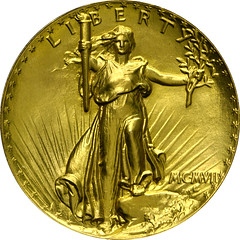 Heritage Auctions announced Wednesday that it has been selected to offer one of the most revered and valuable rare-coin collections in numismatics history: The Harry Bass Core Collection. The historic assemblage of some of the rarest U.S. gold coins and die patterns is estimated to be worth more than $60 million, and proceeds from its sale will benefit the dozens of Dallas-based nonprofits supported by the Harry W. Bass Jr. Foundation with a particular emphasis on early childhood education and literacy in Dallas.
Heritage Auctions announced Wednesday that it has been selected to offer one of the most revered and valuable rare-coin collections in numismatics history: The Harry Bass Core Collection. The historic assemblage of some of the rarest U.S. gold coins and die patterns is estimated to be worth more than $60 million, and proceeds from its sale will benefit the dozens of Dallas-based nonprofits supported by the Harry W. Bass Jr. Foundation with a particular emphasis on early childhood education and literacy in Dallas.
The collection, which the late Dallas oilman and philanthropist Harry W. Bass Jr. began assembling in the 1960s, has been on display at the American Numismatic Association's Edward C. Rochette Money Museum in Colorado Springs, Colo., since October 2000. Earlier this year, the foundation's trustees voted to sell the collection, which contains some 450 U.S. gold coins dating to the late 1700s, to increase its annual giving – from $2 million to at least $5 million each year, depending on the once-in-a-lifetime auction's final results.
GOLD ROMAN COINS FOUND IN NORFOLK
This article describes a cache of Roman gold coins and other items found over several years in a farmer's field in Norfolk and acquired by the British Museum. -Editor
A cache of gold coins found buried on farmland in the United Kingdom has caught the attention of coin experts, who have linked the treasure trove to the Roman Empire.
So far, metal detectorists have discovered 11 coins on a remote stretch of cultivated field located in Norfolk, a rural county near England's eastern coast, and experts remain hopeful that more could be unearthed in the future.
SILVER COINS OF HARALD BLUETOOTH FOUND
Silver coins minted by Viking king Harald Bluetooth have been uncovered in Finland. -Editor
In May of 2022, Finnish metal detectorists discovered a silver cache from the Viking Age in a field in Mynämäki, a municipality of Finland located in the Southwest Finland region.
The follow-up excavations carried out by the Finnish Heritage Agency uncovered silver coins and pieces of silver jewelry.
ANS MAY RETURN PEACE MEDAL TO PAWNEE NATION
Coin World reported that the ANS may be returning an Indian peace medal in its collection to the Pawnee Nation of Oklahoma. -Editor
The American Numismatic Society is seeking to repatriate a silver Abraham Lincoln Indian peace medal struck by the U.S. Mint that has been in the society's collection since 1915 after its removal three years before from the site of a Pawnee Nation burial ground in Nebraska.
THE CARNEGIE HERO MEDAL
Peter Jones submitted this background on the Carnegie Hero Medal. Thanks! -Editor
THE BOOK BAZARRE
R.S. Yeoman and His Remarkable Red Book,also tells the history of Whitman Publishing as well as his own unique life story in and out of numismatics. Enjoy more than 100 years of fascinating numismatic history in 352 richly illustrated pages, 8.5 x 11 inches, hardcover. Order your copy online at Whitman.com , or call 1-800-546-2995.
JOSEF DRACH'S EUROPEAN PEACE DOLLAR
The Vienna Museum of Art History stores the designs and printing plates of Josef Drach's European Peace Dollar. Found via News & Notes from the Society of Paper Money Collectors (Volume VIII, Number 4, July 12, 2022). -Editor
In 1922 Josef Drach personally ordered a design for "European Peace Dollar" banknotes from the artist Alfred Offner [Czernowitz [1879 - 1937] , and even had printing plates prepared. The 2 EFD banknote shows a portrait of the Austrian Nobel Peace Prize winner Bertha von Suttner.
In 1920, Josef Drach, a wealthy Jewish businessman and art dealer from Czernowitz, developed detailed plans for establishing a European Union with Vienna as its capital. Drach raised funds for a European Peace Bank whose goal was to introduce a single currency in Europe: the European Peace Dollar. One side of the coin displayed the image of Bertha von Suttner, the Austrian writer who won the Nobel peace prize in 1905, the other side the slogan: 'Nieder mit den Waffen!' (Down with the Weapons!).
Born in Czernowitz in the year 1883, he came towards the end of World War I to Vienna and established a prosperous art and antiques trade on Dr.-Karl-Lueger Place No. 5.
LOOSE CHANGE: JULY 17, 2022
Here are some additional items in the media this week that may be of interest. -Editor
A CoinWeek article by Michael Shutterly discusses the Legionary Denarii of Mark Antony. -Editor
This denarius was struck for Antony's 3rd Legion. It sold for $1,400 at an auction in January 2021. This legion was probably the legion that appears in the historical record as Legio III Gallica, a legion that Julius Caesar raised during his campaigns in Gaul and which Antony took over after Caesar's death. It is also possible that this was an entirely different 3rd Legion, one which Antony himself raised in North Africa.
To read the complete article, see:
CoinWeek Ancient Coins – The Legionary Denarii of Mark Antony
(https://coinweek.com/ancient-coins/coinweek-ancient-coins-the-legionary-denarii-of-mark-antony/)
Other topics this week include Jim Thorpe's gold medals, and the Undead Numismatist. -Editor

